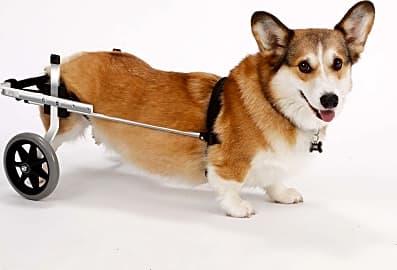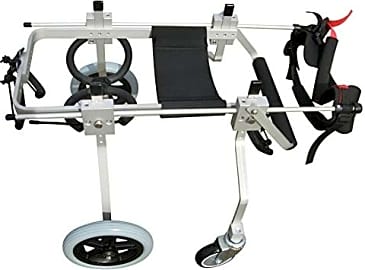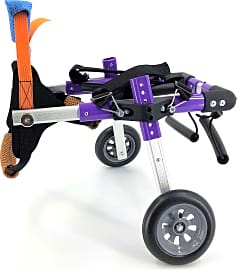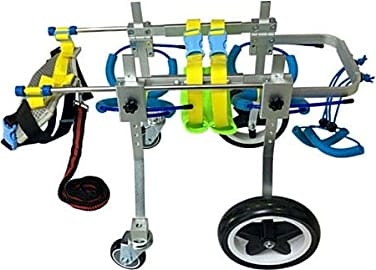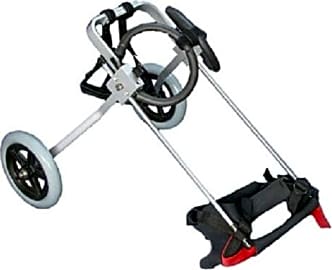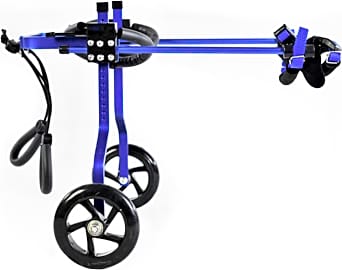The 8 Best Dog Wheelchairs

This wiki has been updated 38 times since it was first published in January of 2016. Got a furry best friend who's struggling to get around due to old age or a disability? Give your pet his or her independence back with one of these dog wheelchairs. They provide convenient, comfortable support for small and large breeds, while allowing them to get around on both indoor and outdoor surfaces. Conveniently, most won't interfere with canines relieving themselves. When users buy our independently chosen editorial recommendations, we may earn commissions to help fund the Wiki.
Editor's Notes
January 09, 2020:
There are few things worse than watching our furry sidekicks struggle with walking. Luckily, you can help during their time of need by providing them with one of these dog wheelchairs. They allow injured or permanently-disabled dogs to regain some of the independence and mobility, so they can continue to enjoy their favorite activities, whether that be fetching their favorite toy or simply chasing their brothers and sisters around the yard.
During this update we removed the Newlife Mobility Rehabilitation due to complaints of it not being very user friendly, some of the bolts loosening too often, and the included straps being too weak for heavy dogs that are still within the recommended guidelines. Thankfully, the Newlife Mobility Quaz, which is a new addition to our list and one of the few four-wheel models available that supports the front and hind quarters, doesn't seem to suffer from the same issues.
We were a bit dismayed that we had to eliminate the Best Friend Mobility SitGo as well, since it is the only model we could find that allowed dogs to sit down while wearing it. Unfortunately, with more than half of users reporting a very bad experience with it for a variety of reasons, we just no longer felt confident recommending it.
One new trend we noticed in the dog wheelchair industry was the addition of some budget-friendly models, like the HiHydro Hind Leg and Sylphid Hind Limb, which seem to offer very similar features to the more expensive options and, as of now, appear to function very well. However, we can't yet attest to how well they will stand the test of time.
On that note, the Walkin' Wheels and K9 Carts Original are premium options developed with input from veterinarians that have proven themselves in a variety of situations. You'll find few complaints of bolts loosening or straps chaffing withe either of these options, and they both come in a range of sizes and allow a lot of adjustability to suit canines of various builds.
Special Honors
Eddie's Wheels Custom Tailored to your dogs disability and designed to be easy to use, a custom model from Eddie's Wheels will make life easier for both you and your furry companion. They are warrantied for the life of your pet, so even though they are pricey, you may actually save money in the end since you'll never have to buy another one. eddieswheels.com
Ruff Rollin Custom If you aren't happy with the fit or features of any of the current models available on the market, you can get your pooch a custom-made wheelchair from Ruff Rollin. Each one is handmade in Montana from aircraft-grade aluminum and designed specifically around the needs of your dog. They come in front, rear, and full-support options and are backed by a lifetime warranty. ruffrollin.com
Restoring Your Pup's Mobility
The rear support wheelchair is the most common type and is equipped with 2 rear wheels, a saddle to support the dog's pelvis, and a harness to keep him or her secure.
Without a wheelchair to supplement or restore at least some degree of a disabled person's mobility, he or she would have a difficult time getting around from one place to another. Just as the device gives a person a sense of normalcy when it comes to completing many of their daily activities, the same quality of life can be given to your cherished pets who may be suffering from temporary or permanent disabilities.
While dog wheelchairs come in many different shapes, sizes, and styles to suit the circumstances, they generally fall into three major categories, which include rear support, front support, and full support (also referred to as a quad cart because the chair supports all 4 legs). The rear support wheelchair is the most common type and is equipped with 2 rear wheels, a saddle to support the dog's pelvis, and a harness to keep him or her secure.
Leveraging a combination of the forelimb muscles and upper torso, a dog is able to walk using the support provided by the device's rear wheels turning behind him and acting as his rear limbs when they've been compromised. The front support wheelchair is so named because its wheels are located in the front of the device instead of the rear. Dogs using a front support wheelchair leverage the power of their hind legs to push themselves around, while the two front wheels substitute the animals' compromised front limbs.
Almost resembling a little bed on four wheels, the full support wheelchair (quad cart) usually features two small front wheels and two large rear wheels with support for a dog's torso region in the middle. The quad cart offers support for all four legs and comes in particularly handy for those pets with neurological disorders and have trouble standing or moving around on their own.
Regardless of the type of wheelchair a dog needs, the devices are often custom fit to the size of the animal, which means that a vet consultation may be required to determine the most suitable option. Many wheelchairs are available in standard sizes that are easily adjustable to fit a range of canine sizes up to a weight of 175 pounds.
Wheelchairs for dogs are specifically-designed to assist those pets afflicted with a variety of conditions that affect different parts of their bodies, including degenerative myelopathy, hip dysplasia, paralysis, arthritis, amputations, or surgery recovery among others. Regardless of the reason for needing a wheelchair, it's important to realize that many canine medical conditions are not a death sentence, even though a wheelchair may be needed for their recovery and treatment.
Dogs (and other animals) are especially resilient and inspiring creatures capable of overcoming extreme physical adversity similar to the way that humans do. For that reason, a dog will become accustomed to the wheelchair in time while still being able to lead a relatively normal life doing the things they love to do. The pet will also appreciate having the freedom to move around the house.
Simplicity And Empowerment Without Disability
The nature of the physical condition will determine the type of wheelchair a person's dog needs. It's important to consult with your veterinarian and remain informed about your options. That said, there are certain qualities to be aware of when making a choice.
The wheels should also be sealed, especially when the dog will be using the device outdoors and on different types of floor surfaces.
Material construction should be a major consideration here. The best dog wheelchairs are durable and made from a combination of aluminum and stainless steel, making them strong, relatively easy to clean, lightweight, and resistant to rust. The wheels should also be sealed, especially when the dog will be using the device outdoors and on different types of floor surfaces. Also, the materials coming into contact with your dog (e.g. the straps or harness) should be made of soft materials like neoprene or another type of strong rubber.
The wheelchair should make it relatively easy to place your dog into it with the least amount of fuss possible. Less fuss means your furry friend will more quickly make a positive association with the device instead of being scared or apprehensive when using it.
Finally, keep an eye on your dog when you first start using the wheelchair to ensure his comfort. One should be sure the straps and wheels are easy to adjust to provide the most effective and natural mobility.
A Brief History Of Dog Wheelchairs
The earliest known record for the history of wheelchairs in general dates back to the sixth century with an inscription on a stone slate in China. By the time of the German Renaissance in the sixteenth century, a wheelchair was invented for King Phillip II of Spain in 1595. This wheelchair was elaborately-designed with both arm and leg rests.
The Bath wheelchair outsold all other types throughout the early part of the 19th century.
In the late eighteenth century, John Dawson of Bath, England designed a wheelchair with two large rear wheels and a small front wheel for easy mobility. The Bath wheelchair outsold all other types throughout the early part of the 19th century. By 1933, mechanical engineers Harry Jennings and Herbert Everest developed the first lightweight and collapsible wheelchair made from steel. Together, this pair founded Everest & Jennings, a company that saw the potential of their invention. The two were able to mass market their well known X-brace, which is still in use today.
The birth of the dog wheelchair concept is generally attributed to orthopedic veterinary surgeon Dr. Lincoln Parkes, owner of K9 Carts, which was the very first United States manufacturer for this type of device. Parkes birthed his idea in 1961 while working at the Animal Medical Center in New York City and recognizing the need for such a tool in his practice. Since that time, Dr. Parkes has dedicated himself and his company to giving freedom and quality of life back to his furry patients for as normal a life as possible.
As of the early 2000s, other manufacturers have continued to establish themselves in the dog wheelchair market, including Mark C. Robinson, founder and president of HandicappedPets.com and inventor of the Walkin' Wheels Adjustable Dog Wheelchair, which has become one of the most popular brands of wheelchair available due to its ability to expand in length, width, and height to accommodate virtually any size or breed.



